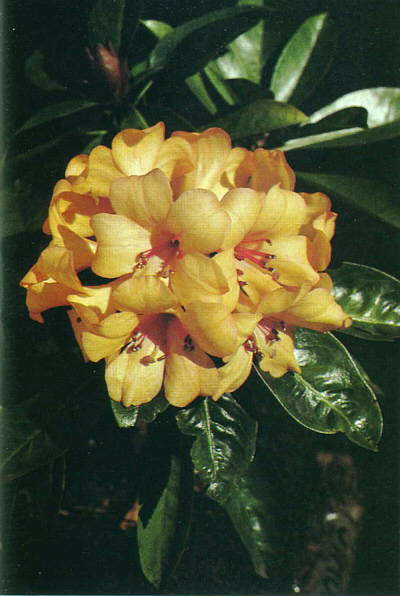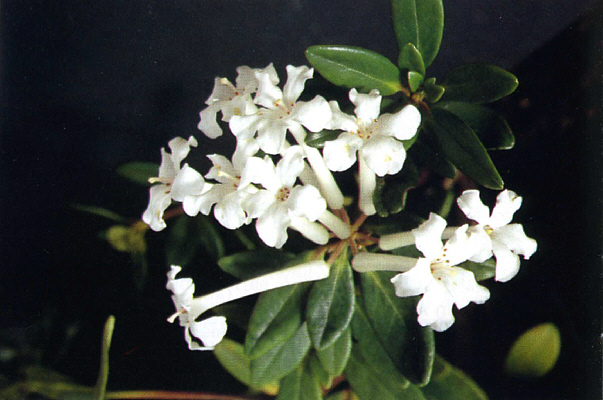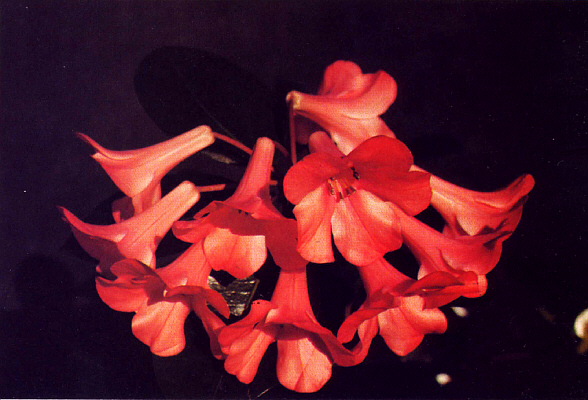QBARS - v35n2 Free Flowering Vireya Rhododendrons
FREE FLOWERING VIREYA RHODODENDRONS
Arthur W. Headlam, Bentleigh, Australia
The idea for this article was the result of a remark made in a letter received from David Leach, dated December 3, 1979:
"It might interest you for me to pass on the information I received from the West Coast, that the vireya hybrid 'Narnia' blooms for eleven months out of twelve in Southern California. Apparently larger plants are virtually continually in flower".
The cross, R. aurigeranum x R. zoelleri was made in Australia in 1968, and seed was sent to Strybing where the plant was raised and introduced by William A. Moynier. A full description appears in the ARS Quart. Bull. Vol. 32 No. 3, Summer 1978, under Plant Registry, p. 100. There does not appear to be a plant of 'Narnia' presently in cultivation in Australia.
I decided to make a record, month by month for 1980, of which vireya rhododendrons in my garden carried flowers. Some notes on climatic conditions prevailing in Melbourne may be of interest; with our relatively mild climate, no greenhouse is required but provision of some modest protection such as a lath house, growing plants under trees and shrubs, under the eaves of a house, or in some location which gives at least some protection from afternoon sun when temperatures in summer months occasionally exceed 100° F., and in winter, when temperatures rarely fall below freezing point, usually the minimums are between 32° F and 40° F., some protection against direct frost is desirable, the previously mentioned provisions being usually adequate.
Different growers use various types of growing media, I find that good results are obtained using a container with a mixture of peat moss or perlite, shredded pine bark or fern log,, thoroughly mixed with well rotted compost; drainage must be very sharp, however, excellent results are obtained when the plant is grown in a piece of tree fern log.
Both methods have the advantage that when plants are flowering they may be brought under the shelter of a 12' x 10' porch at the back door. It is sheltered on two sides by the house and is covered with a fiber glass roof. Under these conditions, individual flowers last for three weeks or more and the plant provides a continuous display for several months in the peak of the flowering season.
Whilst it appears that some growers induce vireya rhododendrons to flower by water stress, that is, withholding water until the plant wilts, then giving it just enough water to revive, and this procedure is repeated for about sixty days, after which normal watering is resumed. This somewhat drastic method is not generally used in Australia, in fact, it would be somewhat difficult to implement in Bentleigh, a suburb of Melbourne, where the average annual rainfall of 33 inches is spread fairly evenly over the year, the average for our summer months being: December 2.42 inches, January 2.28 and February 2.57 inches. February, usually our hottest month and generally considered to be the most difficult for gardens, has recorded rainfall from as low as 0.32 inches to, on the other end of the scale, 8.20 inches in 1973, the highest rainfall in any one month over a ten year period.
I find generally that best results are obtained by maintaining regular watering, which as a rule produces two flushes of growth and two flowering seasons each year. One good soaking once a week is generally sufficient, however in the summer months it may be necessary more often, depending upon the rainfall.
Some comments on prolific flowering species follow, beginning with R. lochiae , the one and only rhododendron indigenous to Australia. It grows in the mountainous rain forests of North Queensland in almost continuously wet and humid conditions in rain, mist or clouds. My plant, in a twelve inch plastic container with a mixture of shredded fern fiber, peat moss and well rotted compost, is dome shaped, two feet high with a three foot spread and carried some flowers for every month in 1980, with the main flowering season in summer and through the fall. During the summer months the container stood continuously in a shallow tray of water. Several other smaller plants of R. lochiae in different parts of the garden flowered profusely, but only the largest plant produced flowers in every month of the year. For color illustration, see ARS Quart. Bull. Vol. 30 No. 2.
The next most prolific species was R. laetum , which carried flowers for ten months of the year. The plant, five feet high with a three foot spread, growing in a piece of fern log, because of its size, presented some difficulties in carrying it to the display area under the back porch, was eventually planted in an easterly aspect where it is in full sun until after mid-day each day. The fern log was buried in the ground in a hole about twice its area and the margin was filled with a mixture of shredded fern fiber and compost and is watered copiously' during the summer months.
Brian Clancy was probably one of the first growers of vireya rhododendrons in Australia to use copious watering to force plants into two growing seasons and two flowering seasons in one year. His first success was with R. laetum , after reading a description of this species by Dr. Sleumer in 'An account of rhododendron in Malesia'. p. 639: "Ecol. On edge of primary and secondary forest, and in open marsh, often in swamps near lake shore, 1800-2300 m. Fl. Jan./Dec. Note. Much related to R. zoelleri ". Dr. Sleumer also stated in his lecture to the Portland Study Club, ARS, November 1976, p. 11:
"This is a peat bog, and the locality of R. laetum - if you want to get it you go ankle to knee deep in mud, in open sun, no forest, absolutely exposed to full sun. This gives you a general idea of this part of New Guinea".
Brian experimented and came to the conclusion that other vireyas responded equally well to this treatment, and this led to his article. To water or not to water. ARS Quart. Bull. Vol. 32 No. 1.
R. christianae , was the first New Guinea species to be raised and flowered in Australia, from seed collected in the Daga country by Canon N. E. G. Cruttwell. My largest plant, four feet high with a similar spread, is growing in a piece of tree fern log in a shade house. In fact, several other plants in this particular corner are all planted in pieces of tree fern log, which have been buried to the top of the log in sawdust, which serves the purpose of suppressing weeds as well as holding moisture for a considerable time when it becomes thoroughly wet, producing a humid micro-climate in this area, its success is evidenced by the fact that R. christianae produced flowers for ten months of the year.

|
|
R. javanicum
All photos by author |

|
| R. jasminiflorum |
Other species which produced flowers over a period of eight months were R. jasminiflorum and R. javanicum , the latter, a relatively small plant three feet high will no doubt be a contender for the flower in every month class as it increases in size.
It may be of interest to note that some of the vireya species which produce the larger flowers such as R. zoelleri (Michael Black form), with trusses of up to nine flowers each five inches in diameter and a form of R. konori collected in eastern New Guinea carried up to seven flowers measuring six inches across the lobes, seem to have a set flowering season, R. zoelleri in mid-spring and R. konori in summer months. Neither produce out-of-season flowers, presumably the effort of producing one crop of extremely large flowers is as much as the plant can stand, although R. laetum does produce a profusion of flowers each three and one half inches in diameter and up to eleven to the truss, which can hardly be classed as small, over a period of ten months of the year. Now follows a description of some of the most prolific flowering hybrids, four of which carried some flowers in each month of the year.

|
| R. christianae x R. lochiae F2 |
'Petra' ( R. christianae x R. jasminiflorum ), was one of the early hybrids made in Australia. It is quite hardy and my plant, four feet high carries 'good foliage, the leaves being larger than those of either parents, and its long narrow tubular flowers, blush white in color, with a protruding stigma, expand into five lobes of a blush pink. It is easy to propagate and flowers consistently throughout the year, perhaps somewhat unobtrusively on account of the pastel colors. It has not inherited the perfume of R. jasminiflorum .

|
| R. laetum x R. javanicum |
R. laetum x R. javanicum , another locally raised hybrid, is a vigorous grower with deep green glossy foliage. My plant, growing in a piece of fern log is six feet high and flowers consistently carrying trusses of up to eleven flowers which are intermediate in color between its parents. It flowers are in fact regularly cut, otherwise the plant would be pushing through the top of the shade house seven feet high.
R. laetum x R. phaeopeplum , the new growth resembles that of R. phaeopeplum and is intermediate between the two when mature, produces a profusion of funnel shaped flowers, three inches across the lobes, cream with a deep pink margin to the five to seven lobes. It is a consistent flowerer and makes quite a spectacular display in late spring and early summer, its main flowering season. The plant is four feet high with a similar spread.
The first vireya rhododendron raised in Australia was R. christianae , and hybridists were soon at work and R. christianae was crossed with R. lochiae , the only rhododendron indigenous to Australia. Seed was germinated and plants were grown on and it was with considerable interest that the first flowers were awaited, however, R. lochiae proved to be the dominant parent color wise and this pattern generally followed with subsequent hybrids. It was my friend Brian Clancy who decided to persevere with R. lochiae and he eventually selfed his R. christianae x R. lochiae hybrid, thus creating the F2 progeny with some quite startling results. The flowers were larger, some with frilled edges and pleasingly extended over a much wider range of colors, from pale pink flushed salmon through the intermediate shades to a bright red. The second generation progeny are a decided improvement upon their parents. The flowers are much larger, two and one half inches across the lobes and carry up to ten flowers to the truss. They are of greater substance whilst the leaves are greener and more leathery. The F2 is easier to strike and easier to grow. It produced flowers in every month in 1980 and it is interesting to note that it has followed the growth habit of R. lochiae by forming a ground hugging dome shaped plant, quite the reverse to the original R. christianae x R. lochiae hybrid, my plant of which is pushing through the top of the shade house seven feet in height, and has a normal flowering season of some three months, rarely producing any out of season flowers.
Next on the list with flowers for ten months of the year is 'Pink Delight', one of the many hybrids produced by the famous English nursery of Veitch almost one hundred years ago. The largest plant is three feet high with a four foot spread. 'Pink Delight' was described and illustrated in color in the ARS Quart. Bull. Vol. 27 No. 1.
This is closely followed by 'Dr. Herman Sleumer', a natural hybrid between R. phaeopeplum and R. zoelleri , which carried flowers for nine months of the year. My plant, now seven years old is barely three feet high and carries tubular funnel shaped flowers, creamy yellow in the tubes with deep pink flared lobes, four to six flowers to the truss with five, six or seven lobes. Foliage is intermediate between the two parents. I find it somewhat sun tender necessitating a well sheltered position, quite the reverse to R. laetum x R. phaeopeplum and R. aurigeranum x R. phaeopeplum which are quite sun tolerant. It is of interest that the flowers of 'Dr. Herman Sleumer' are of a much brighter color in the fall, the lobes instead of being tinged with pink are almost scarlet.
Other Veitch hybrids which produced flowers for six months of the year were 'Triumphans' and 'Red Prince', and I am sure that as they increase in size they will further extend their flowering season, but 'Souvenir de J. H. Mangles', for me is an extremely vigorous grower and all of its energies seem to be expended in the production of new growth rather than flowers, but this may well be rectified as the plant increases in size.
So ends the description of vireya rhododendrons, both species and hybrids which have qualified for inclusion in this paper by producing flowers for from six to twelve months of the year, but there are many in the four to five months category, which with the passing of time will no doubt produce flowers over a longer period.
